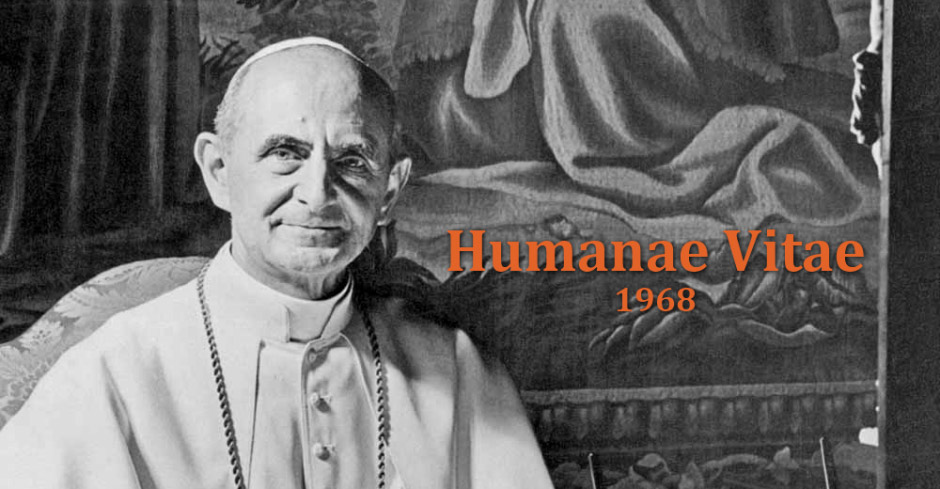The stone the builders rejected

By JOSEPH DOYLE
From the moment of its publication, Humanae Vitae (Of Human Life) was controversial. Its prohibition of artificial contraception made it one of the most divisive, despised and unfashionable publications in the Church’s history. However, fifty years after its release, in the light of new evidence, Humanae Vitae is finally getting some of the recognition that it deserves.
Written in 1968 by the soon to be canonised Pope Paul VI, the encyclical letter on the regulation of births was written to reaffirm the traditional Catholic position on married love, responsible parenthood and the use of contraception.
In it, Pope Paul VI beautifully reiterates the good of married love as created by God so that “husband and wife become in a way one heart and one soul, and together attain their human fulfillment.” (HV, 9). Pope Paul was also clear that sex and marriage were designed to be fruitful and is “ordained towards the procreation and education of children.” (HV 9).
As a result, Pope Paul VI advised married couples to use natural infertile periods to space out children instead of using contraceptives, all of which are “no act of true love” because they deprive sex and marriage of their “meaning and purpose,” (HV 13).
However, by the time the encyclical was written the sexual revolution was in full swing, promising liberation from restraints on sexual freedom. The encyclical was also written amidst pervasive fears of a global overpopulation crisis due to unregulated births.
The aftermath of Vatican II
In the immediate aftermath of the Second Vatican Council, the Church was expected to stride into the modern era by rescinding many of their traditional teachings. The Anglican Church had approved in 1930 and, except the Eastern Orthodox churches, all of the other major Christian denominations had followed suit.
The Catholic Church was the only major institution left in a world that, both inside and outside of the Church, was growing more and more hostile to the prohibition of contraceptives.
The Pope’s answer ought to have been a foregone conclusion.
For many Western Catholics at the time, as now, Humanae Vitae was an embarrassment. In a world that almost universally acknowledged contraception as a necessity for freedom, relationships, and responsible parenthood, the vast majority of Catholics ignored or protested against the Church’s definitive teaching on this issue.
It was declared invalid by many theologians and clergymen, ignored by the hostile majority of Western Catholics and derided by the secular world.
However, much has changed in the fifty years since its writing.

The Bomb that didn’t go off
Widely available contraception was thought to be the solution to the over-population crisis. In reality, there never was an over-population crisis. Modern studies have dismissed the ‘Population Bomb’ as built on a mix of flawed science and ideological fear mongering.
Over-population science has been so thoroughly debunked that modern theorists are worried about precisely the opposite problem. What we have inherited instead is demographic disaster through plummeting birth rates and rapidly aging populations.
The myth of the over-population crisis, despite assurances to the contrary, gave license for international governments, such as in India and China, to forcibly sterilize undesirable segments of their populations.
Contraceptives have also been explicitly targeted to poor people in third world countries by Western governments. Contraceptives are, thus, still relatively unpopular in Africa and Latin America, where the people who live there seem somewhat unenthused that there are those in first world countries who think there should be less of them and have funded organisations accordingly.
Widespread birth control was thought to enable women control of their destinies and bodies, resulting in increased respect and liberation. However, the undeniable decline in moral standards and rise in sexual license and promiscuity have led to the unparalleled disrespect and degradation of women.
The years since 1968 have witnessed the growth of the now ubiquitous nature of pornography, soaring cases of sexual assault and the declining rates of women’s happiness.
Degradation of women
The last fifty years have democratised the degradation of women, who are objectified, abused and made miserable like never before. Growing rates of violence against women suggest that, in accordance of the vast weight of modern social science, the sexual revolution has instead served the interests of aggressive and abusive men, allowing them to use women as instruments of their desire without unintended consequences of their sexual misadventures.
The incredible thing about Humanae Vitae is that Paul VI predicted both of these outcomes back in 1968. He predicted that mainstream contraceptive use would lead to a “general lowering of moral standards,” the reducing of women to “a mere instrument for the satisfaction of his desires” and the coercive use of contraceptives by governments. (HV 17).
The fact that all of this came to pass is nothing short of astonishing and casts Humanae Vitae as a prophetic masterpiece, instead of as a regressive embarrassment.
And now…
So what is it about the mainstream use of contraceptives that have made all of this possible?
The loss of the procreative element of sex for the elevation of sexual pleasure has meant that our society has lost traces of both.
The widespread use of contraceptives had a cheapening effect on sex, marriage, children and the human person, all of which became expendable when separated from each other. Sex was no longer “fully human” and “a compound of sense and spirit” (HV 9), but just an avenue for personal pleasure. The family was no longer a place of “mutual love” (HV 13), but something to be corralled and repressed.
Sure, contraceptives didn’t affect everyone in the same way at the same time, but it pulled the pin on the natural traits that kept the dignity of sexuality and the human person together. Once it was gone, the binding of such relationships was held in place only by societal custom, one that is in rapid decline.
As Pope Francis is fond of saying, “The realities outweigh the ideals.” In this case, the realities of human nature have outweighed the ideals of the sexual revolution. The result of which is that the single most reviled, controversial and subsequently ignored Church document in modern history has turned out also to be the most prophetic.
Vindicated by an avalanche of secular and empirical evidence, Paul VI’s warnings are a “sign of contradiction” with the society and church that turned its back on his encyclical.
As the Gospel of Matthew says, ‘The stone which the builders rejected has become the cornerstone. And it is a marvel to us.’


